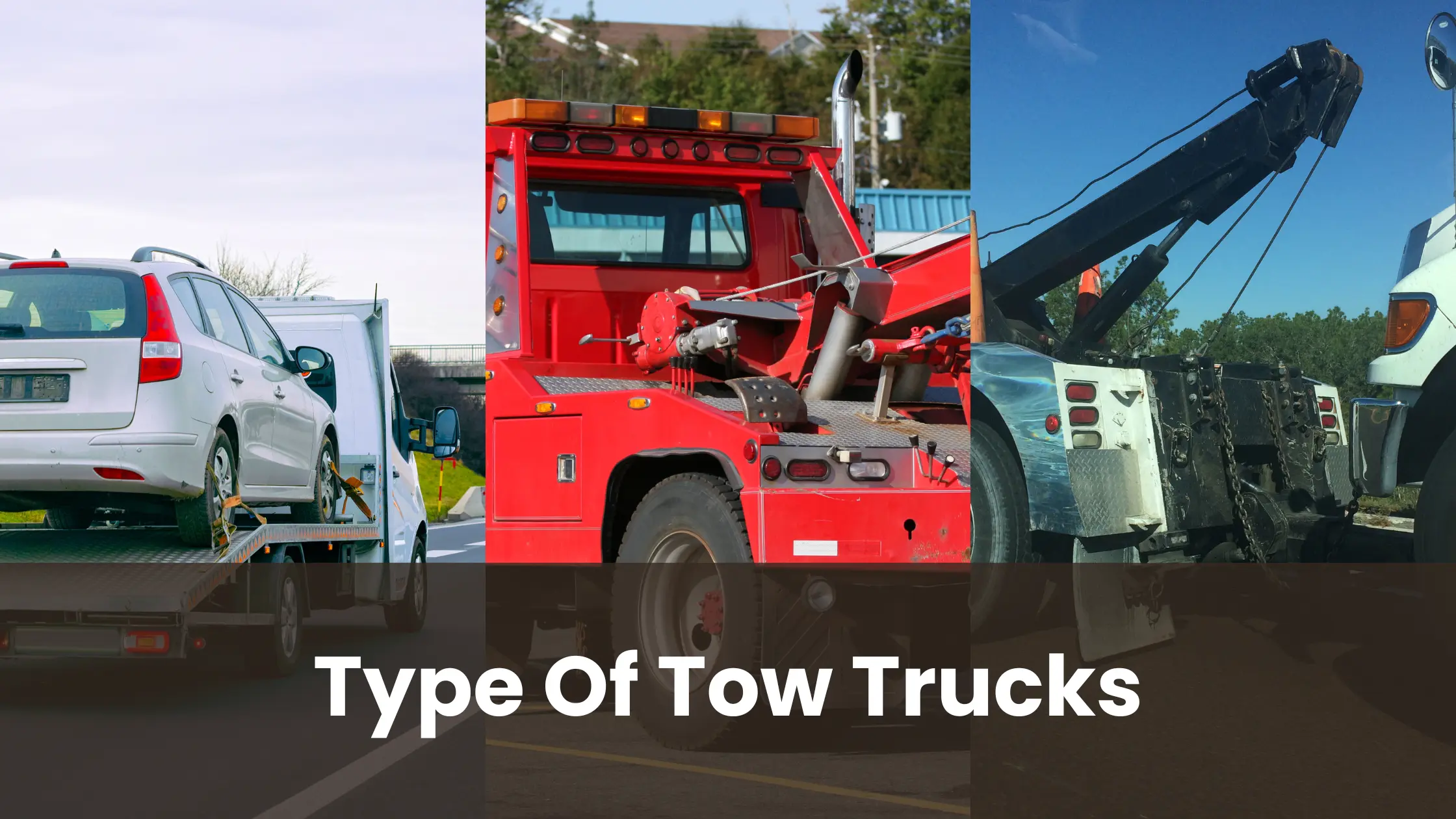What Are The Different Type Of Tow Trucks?
Have you ever found yourself stranded on the side of the road, wondering what kind of tow truck will come to your rescue? 
In this blog post, we’ll take you on a journey through the fascinating world of tow trucks. You’ll discover the unique features and capabilities of five different types of these road warriors. Whether you’re a car enthusiast, a curious driver, or someone who simply appreciates the unsung heroes of our highways, this guide will give you a newfound appreciation for the versatility and ingenuity of tow trucks.
From the classic hook and chain to the modern integrated systems, we’ll explore how each type of tow truck plays a crucial role in keeping our roads clear and our vehicles safe. So buckle up and get ready to dive into the world of flatbeds, wheel-lifts, and heavy-duty haulers that make up the backbone of roadside assistance!
Flatbed Tow Trucks: Versatile Haulers
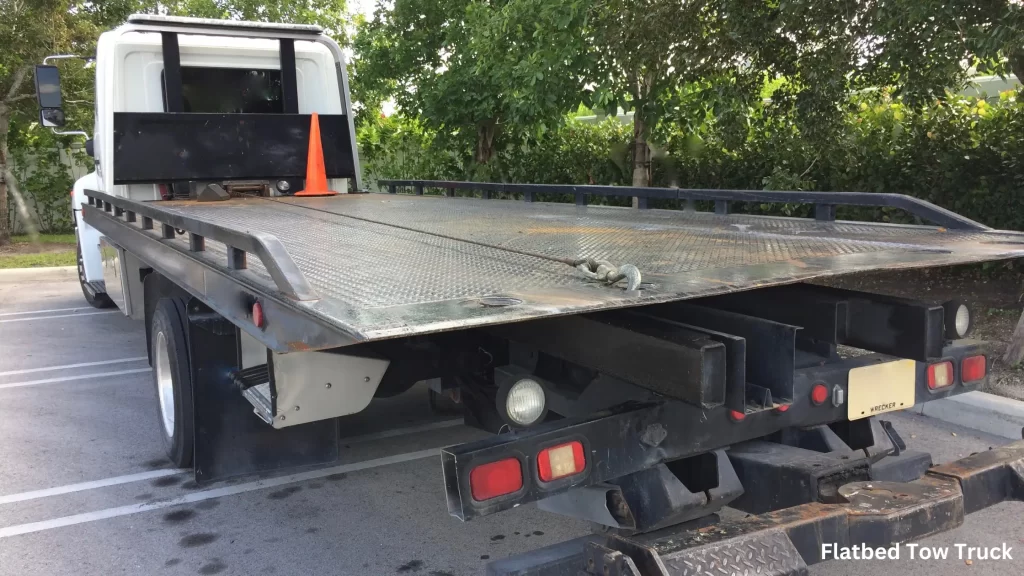
Ideal for long-distance towing
Flatbed tow trucks excel in long-distance towing due to their stable and secure platform. Unlike other tow trucks, flatbeds completely lift the vehicle off the ground, eliminating wear and tear on tires during transport. This makes them the go-to choice for cross-country moves or transporting vehicles between cities.
Safe transport for luxury and low-clearance vehicles
When it comes to high-end or low-clearance vehicles, flatbed tow trucks are unparalleled in their ability to provide safe transportation. The flat loading surface ensures that no part of the vehicle touches the ground, preventing potential damage to expensive undercarriages or low-hanging components.
| Vehicle Type | Flatbed Advantage |
|---|---|
| Luxury Cars | No stress on suspension |
| Sports Cars | Protects low-clearance parts |
| Classic Cars | Prevents road debris damage |
Capacity to handle multiple vehicles at once
One of the most significant advantages of flatbed tow trucks is their ability to transport multiple vehicles simultaneously. This feature is particularly useful for:
Car dealerships moving inventory
Auto auctions transporting sold vehicles
Accident scene clearance
Fleet relocations
Easy loading and unloading process
The loading and unloading process with a flatbed tow truck is straightforward and efficient:
The flatbed tilts to create a ramp
The vehicle is winched or driven onto the bed
The vehicle is secured with straps or chains
The bed is leveled for transport
This simple process minimizes the risk of damage and allows for quick turnaround times, making flatbed tow trucks a favorite among towing professionals and vehicle owners alike.
Hook and Chain Tow Trucks: The Classic Option
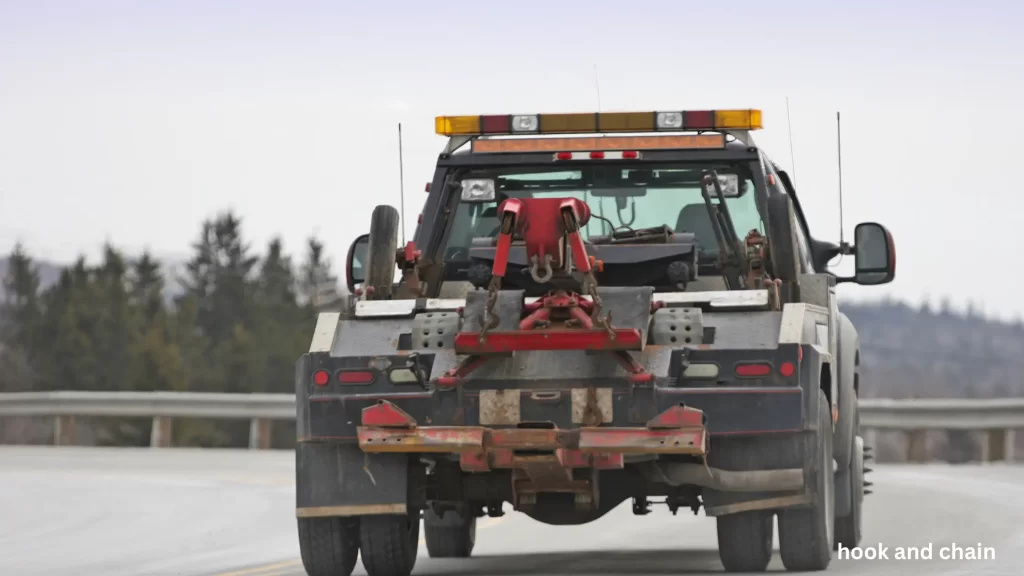
Best for damaged or non-operational vehicles
Hook and chain tow trucks have long been the go-to solution for towing severely damaged or non-operational vehicles. These trucks excel in situations where:
Vehicles have sustained extensive damage
Cars with non-functional wheels or axles
Vehicles stuck in ditches or difficult terrain
Their robust design allows them to lift and secure vehicles that other tow trucks might struggle with, making them invaluable in emergency situations.
Cost-effective towing solution
One of the primary advantages of hook and chain tow trucks is their cost-effectiveness. Here’s a comparison of towing costs:
| Tow Truck Type | Average Cost per Mile |
|---|---|
| Hook and Chain | $2.50 – $5.00 |
| Flatbed | $3.50 – $7.00 |
| Wheel-Lift | $3.00 – $6.00 |
This cost-effectiveness stems from:
Simple design requiring less maintenance
Lower fuel consumption compared to larger trucks
Faster hookup times, allowing for more jobs per day
Potential risks to vehicle’s bumper and frame
While hook and chain tow trucks offer many benefits, they do come with some potential risks:
Bumper damage: The chain can scratch or dent the bumper
Frame stress: Improper attachment can put undue stress on the vehicle’s frame
Suspension strain: Lifting only one end of the vehicle may affect suspension components
To mitigate these risks, operators must be highly skilled and use proper techniques when securing vehicles. Despite these potential drawbacks, hook and chain tow trucks remain a valuable tool in the towing industry, especially for salvage operations and emergency recoveries.
Wheel-Lift Tow Trucks: Modern and Efficient
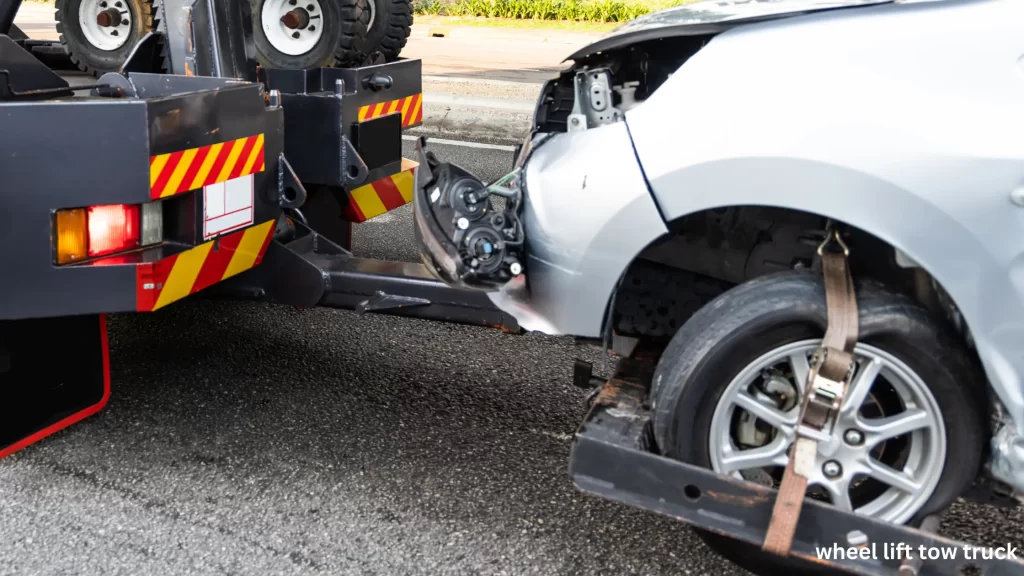
Gentle on vehicle’s drivetrain
Wheel-lift tow trucks have revolutionized the towing industry with their modern design and efficient operation. One of the key advantages of these trucks is their gentle approach to handling a vehicle’s drivetrain. Unlike traditional hook and chain methods, wheel-lift systems cradle the drive wheels, significantly reducing stress on the transmission and other vital components.
Suitable for both front and rear-wheel drive cars
The versatility of wheel-lift tow trucks is unmatched when it comes to handling different types of vehicles. These trucks can easily adapt to tow both front-wheel and rear-wheel drive cars with minimal adjustments. This flexibility makes them a preferred choice for towing companies and roadside assistance services.
| Vehicle Type | Towing Method |
|---|---|
| Front-wheel drive | Lift rear wheels |
| Rear-wheel drive | Lift front wheels |
| All-wheel drive | Use flatbed or dolly |
Quick hookup process for faster service
One of the most significant advantages of wheel-lift tow trucks is their rapid hookup process. This efficiency translates to faster service times, which is crucial in emergency situations or when clearing accident scenes. The streamlined process typically involves:
Positioning the truck
Lowering the wheel-lift mechanism
Securing the vehicle’s wheels
Raising the lift and locking it in place
Reduced risk of vehicle damage compared to hook and chain
Wheel-lift tow trucks offer a superior level of protection for the towed vehicle. By eliminating direct contact with the vehicle’s body, these trucks minimize the risk of scratches, dents, or other cosmetic damage. This gentle approach is particularly valuable when towing luxury or classic cars, where preserving the vehicle’s appearance is paramount.
Now that we’ve explored the benefits of wheel-lift tow trucks, let’s move on to discuss integrated tow trucks, which combine multiple towing capabilities into a single vehicle.
Integrated Tow Trucks: All-in-One Rescue Vehicles
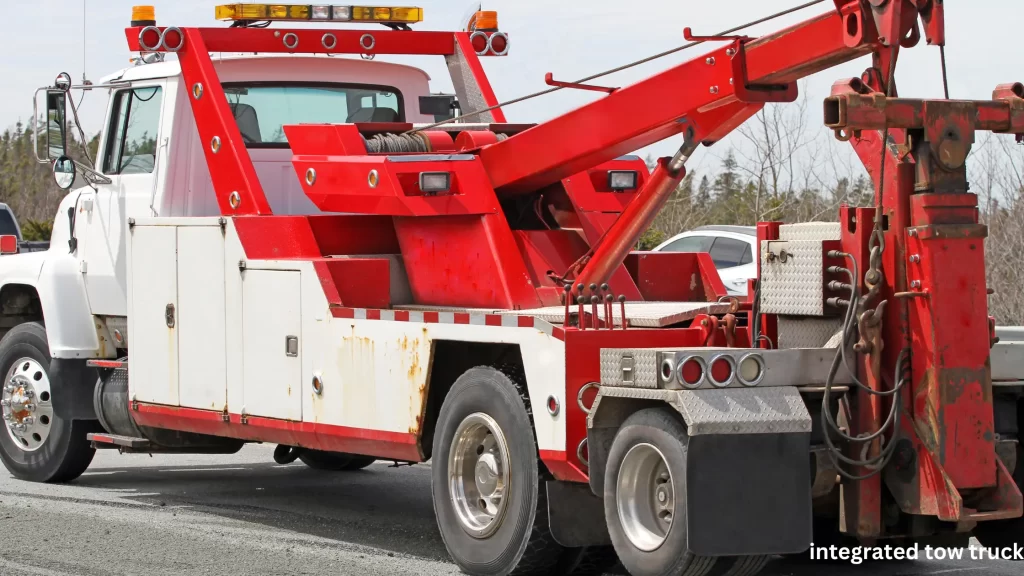
Combines features of wheel-lift and flatbed trucks
Integrated tow trucks represent the pinnacle of towing technology, seamlessly blending the capabilities of wheel-lift and flatbed trucks into a single, versatile vehicle. These all-in-one rescue machines offer unparalleled flexibility, making them ideal for a wide range of towing scenarios.
| Feature | Wheel-Lift | Flatbed | Integrated |
|---|---|---|---|
| Lifting mechanism | Yes | No | Yes |
| Full vehicle support | No | Yes | Yes |
| Vehicle size capacity | Limited | Wide range | Wide range |
| Versatility | Moderate | High | Very High |
Adaptable to various towing situations
The true strength of integrated tow trucks lies in their adaptability. These vehicles can effortlessly switch between different towing methods, allowing operators to tackle diverse situations with ease. Some key advantages include:
Quick response to various vehicle types and conditions
Ability to handle both standard and unconventional towing requests
Reduced need for multiple specialized trucks in a fleet
Equipped with advanced recovery tools
Integrated tow trucks come outfitted with a comprehensive array of cutting-edge recovery tools, further enhancing their rescue capabilities. These may include:
Powerful winches for vehicle extraction
Hydraulic boom systems for precise lifting
Specialized rigging equipment for secure towing
Advanced lighting systems for nighttime operations
With these advanced features, integrated tow trucks stand ready to handle even the most challenging recovery situations, making them an invaluable asset for towing companies and emergency services alike.
Heavy-Duty Tow Trucks: Tackling the Big Jobs
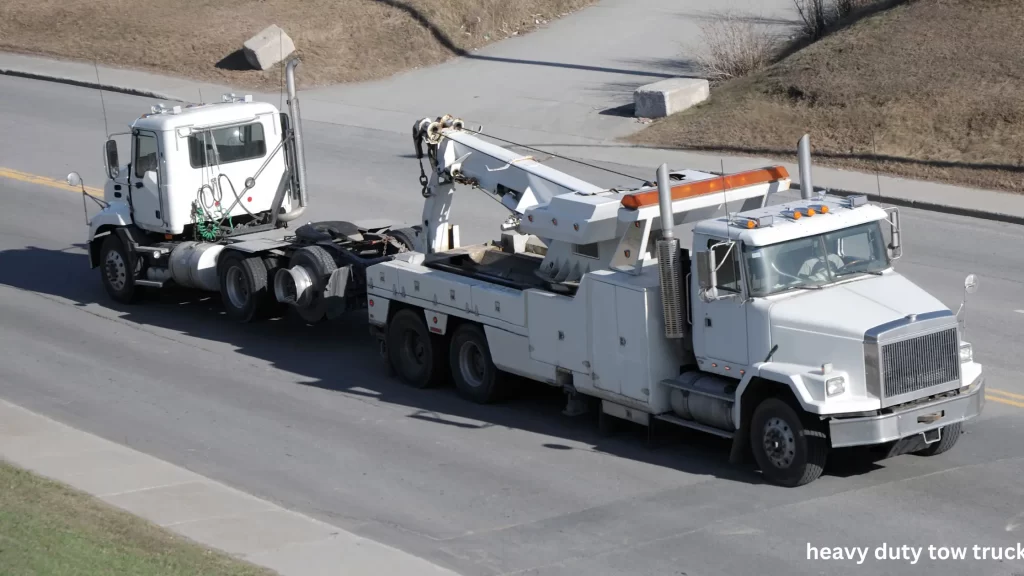
Designed for large vehicles and commercial equipment
Heavy-duty tow trucks are the giants of the towing world, specifically engineered to handle massive vehicles and equipment. These powerhouses are capable of towing:
Semi-trucks and trailers
Buses
Construction machinery
Large recreational vehicles (RVs)
Their robust construction and reinforced components allow them to safely manage loads that would overwhelm standard tow trucks.
Powerful winching capabilities
One of the most impressive features of heavy-duty tow trucks is their exceptional winching power. These trucks are equipped with:
| Winch Feature | Capability |
|---|---|
| Pull capacity | Up to 100,000 lbs |
| Cable length | 150-300 feet |
| Motor power | 20-30 horsepower |
This extraordinary winching ability enables operators to recover vehicles from challenging situations, such as deep ditches or steep embankments.
Specialized attachments for unique towing needs
Heavy-duty tow trucks come with a variety of specialized attachments to address diverse towing scenarios:
Underlift systems
Sliding axle trailers
Rotator arms
Air cushion recovery systems
These attachments allow operators to adapt to different recovery situations, ensuring safe and efficient towing of even the most challenging loads.
Essential for accident scene clearance
When major accidents occur, heavy-duty tow trucks are indispensable. They play a crucial role in:
Clearing overturned semi-trucks
Removing damaged buses from highways
Recovering submerged vehicles from bodies of water
Their ability to handle large-scale operations makes them essential for restoring traffic flow and ensuring public safety after severe accidents.
Tow trucks come in various types, each designed to handle specific vehicle recovery situations. From the versatile flatbed trucks to the classic hook and chain models, modern wheel-lift variants, all-in-one integrated units, and powerful heavy-duty tow trucks, there’s a solution for every roadside emergency.
Understanding the different types of tow trucks can help you make informed decisions when calling for assistance. Whether you’re dealing with a simple breakdown or a complex recovery scenario, knowing which tow truck is best suited for your situation can ensure a safer, more efficient resolution to your vehicle troubles. Remember, professional towing services have the expertise to choose the right equipment for your needs, ensuring your vehicle’s safety and minimizing potential damage during transport.
